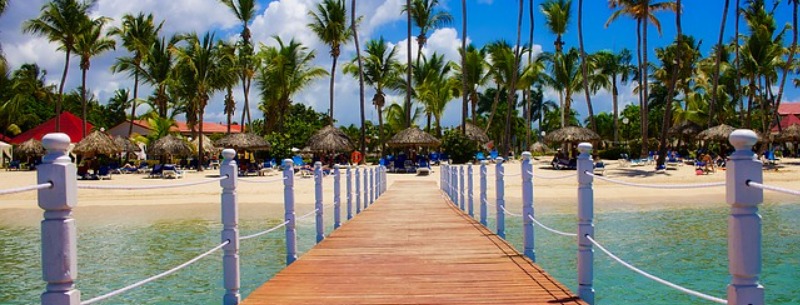The Dominican Republic is a beautiful Caribbean country. It is best known for its luxurious all-inclusive resorts, but that is not the only thing this country has to offer. There are also postcard-worthy beaches along the coast, complete with soft white sand, clear water, and soaring palm trees.
Occupying the eastern half of the island of Hispaniola, the Dominican Republic is a hugely popular destination, thanks to the portion of the country that most resembles the image of a Caribbean playland: the crystal-clear waters and sandy beaches lined with palm trees, of which the Dominican Republic has plenty.
This vision of leisurely days spent by the sea and romantic nights filled with merengue and dark rum is supported by what turns out to be the largest all-inclusive resort industry in the world.
Set on the most geographically diverse Caribbean island, the Dominican Republic also boasts virgin alpine wilderness, tropical rainforests and mangrove swamps, cultivated savannas, vast desert expanses and everything in between within its relatively small confines providing staggering opportunities for ecotourism and adventure travelling.
It is never too early or too late to begin planning your ideal beach vacation. The Dominican Republic is an ideal beach destination, with pristine shores and sandy spots all over the Caribbean. Check out our list of best Dominican Republic beaches to get motivated.
Playa Bonita and Playa Coson
Playa Bonita, 13km of uninterrupted beach that begins just west of Playa Las Ballenas, boasts the kind of powdery white sand you might expect to see only in tourist brochures.
There’s been a fair bit of development in recent years but this has been done carefully and the hotels do little to detract from the beauty and serenity of the heavenly beaches.
Indeed, if you’re looking for natural beauty, peace and quiet, you’re far better off staying here than in Las Terrenas.
From Playa Bonita’s entrance, a sand road provides access for four-wheel-drives and motorbikes, past a beachfront populated at most by a few small groups of people taking advantage of the isolation to swim or sunbathe naked, until, after 6km, you reach Playa Coson, a small fishing village holding two gourmet beach shacks with tables and chairs on the sand, serving grilled, fresh-caught fish for a few pesos.
Samana Peninsula
It’s not hard to appreciate the beauty of the Samana Pennsula, a thin strip of land poking from the Dominican Republic’s northeast.
Perhaps the most appealing part of the whole country, the region boasts a coast lined with beaches that conform strictly to the Caribbean archetype of powdery white sand and transparent green-blue sea.
Besides bumming on the beach, visitors come to see the thousands of humpback whales that migrate to the Bahia de Samana during the winter. Most whaleboats depart from Santa Barbara de Samana (generally shortened to Samanб), the largest town on the peninsula and a welcome break from the more typical beach-oriented tourist resorts.
If the hustle and bustle of more typical Dominican towns becomes too much for you, head east to Las Galeras, a pristine horseshoe of sand that, despite considerable development in recent years, still maintains an air of tranquillity.
Along the peninsula’s north coast you’ll find the beautiful beaches of the remote expat colony of Las Terrenas, a burgeoning hangout for independent travelers.
Santo Domingo
Santo Domingo isn’t the tropical paradise most travelers come to the Caribbean in search of, but at the core of the rather bewildering sprawl the old Spanish colonial capital – the very first European city of the New World – lies magically intact along the western bank of the Rio Ozama.
This was the domain of Christopher Columbus : founded by his brother Bartolome, ruled by him for a time and claimed a decade later by his son Diego. After five centuries, the Columbus palace can still be found alongside the cobblestone streets and monumental architecture of the walled, limestone city the family built.
Far more than just history makes Santo Domingo an integral part of any trip to the Dominican Republic; it is, after all, the modern face of the country, and as such has a non-stop liveliness not seen in many other places.
The vitality extends, though in a slightly more disappointing manner, to the very reachable beaches east of the city, at Boca Chica and Juan Dolio, both fairly built-up resorts.
Silver Coast
The Dominican Republic’s Silver Coast, 300km of prime waterfront property on the country’s northern edge, is the most popular tourist destination in the Caribbean.
With a seemingly unending supply of great beaches around the booming towns of Puerto Plata and Cabarete, such a designation is no surprise.
The Carretera 5 skirts the coast all the way east from Samana to just past Puerto Plata, making getting around this part of the region a breeze.
The country’s two major bus companies ply the highway, along with the guaguas and plentiful publico taxis.
Heading west of Puerto Plata is more of a challenge (but not impossible) if you don’t have a four-wheel-drive.
Southeast Dominican Republic
The Santo Domingo valley stretches east along the coast from the capital, encompassing vast tracts of sugarcane.
North of these fields roll the verdant hills of the Cordillera Oriental, which terminate at the bowl-shaped swamp basin of Parque Nacional Los Haitises.
This is the Dominican Republic’s Southeast , known primarily for its popular resort zones Bavaro and Punta Cana, bookends of a thirty-kilometre strip of uninterrupted sand lined with all-inclusives.
Past these attractions, the Southeast is fairly poor, rural and bereft of must-see sights – with the exception of two national parks.
Parque Nacional del Este, poking into the Caribbean at the southeastern tip of the Dominican Republic, continues the theme of great beachfront, especially along Isla Saona, while the mangrove swamps of Parque Nacional Los Haitises hide several Taino caves visited by boat.
